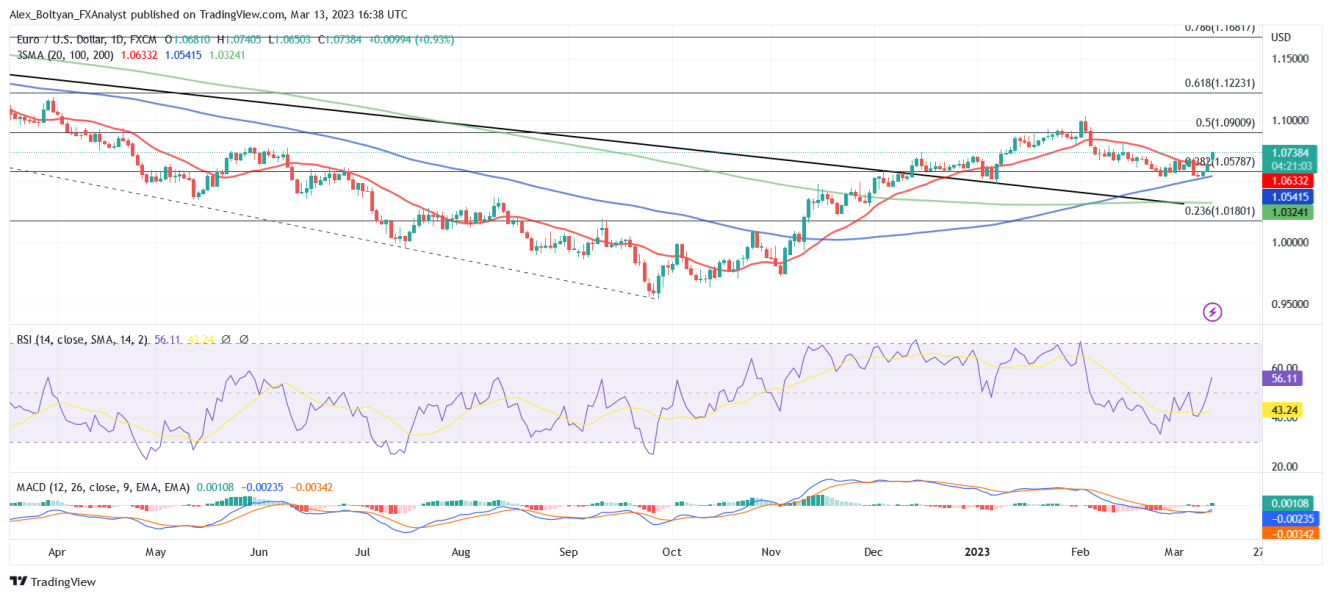The EUR/USD pair advanced beyond the 1.0700 level on Monday despite the risk-off environment prompted by the Silicon Valley Bank shutdown. The greenback suffered the pressure of lower U.S. yields amid expectations the Federal Reserve will have to hold the trigger on rates amid the banking sector turmoil and somewhat disappointing jobs data.
At the time of writing, the EUR/USD pair is trading at 1.0730, up 0.85% on the day, after hitting a one-month high of 1.0738. Meanwhile, the US Dollar Index has fallen below the 104.00 level to trade at its lowest level since February 16, around 103.65, recording a 0.95% daily loss.
Investors' focus now shifts to U.S. consumer inflation data on Tuesday as President Joe Biden attempts to calm down banking system fears. Still, the banking crisis could offset macroeconomic data ahead of the Fed's meeting.
Investors are cutting down expectations of a 50 bps rate hike at the March 21-22 meeting. Against this backdrop, the U.S. bond yield plummeted across the curve on Monday, as the 10-year yield is trading at 3.47%, down by nearly 6%. The 2- and 5-year bond rates stand at 4.17% (-9%) and 3.69% (-6.8%), respectively.
The market's pace will likely continue to be driven by risk flows and investors' expectations on how the Fed will respond. FOMC officials must now weigh the trade-off between controlling inflation and lending some air to the financial system.

From a technical perspective, according to indicators on the daily chart, the EUR/USD pair holds a slightly bullish short-term outlook. The RSI and MACD jumped to positive territory, and the pair now trades above its main moving averages.
On the upside, the following resistance levels line up around 1.0740 and at the 1.0800 level ahead of the more relevant 1.0900 zone, which is the 50% retracement of the 1.2266-0.9535 decline. On the downside, supports are seen at the 20-day SMA at 1.0630, followed by the 1.0600 psychological mark and the 1.0540 zone (100-day SMA).
- English (UK)
- English (India)
- English (Canada)
- English (Australia)
- English (South Africa)
- English (Philippines)
- English (Nigeria)
- Deutsch
- Español (España)
- Español (México)
- Français
- Italiano
- Nederlands
- Português (Portugal)
- Polski
- Português (Brasil)
- Русский
- Türkçe
- العربية
- Ελληνικά
- Svenska
- Suomi
- עברית
- 日本語
- 한국어
- 简体中文
- 繁體中文
- Bahasa Indonesia
- Bahasa Melayu
- ไทย
- Tiếng Việt
- हिंदी
EUR/USD Rises Past 1.0700 as Investors Bet on Less Aggressive Fed
Published 03/13/2023, 12:45 PM
Updated 07/09/2023, 06:32 AM
EUR/USD Rises Past 1.0700 as Investors Bet on Less Aggressive Fed
Latest comments
Loading next article…
Install Our App
Risk Disclosure: Trading in financial instruments and/or cryptocurrencies involves high risks including the risk of losing some, or all, of your investment amount, and may not be suitable for all investors. Prices of cryptocurrencies are extremely volatile and may be affected by external factors such as financial, regulatory or political events. Trading on margin increases the financial risks.
Before deciding to trade in financial instrument or cryptocurrencies you should be fully informed of the risks and costs associated with trading the financial markets, carefully consider your investment objectives, level of experience, and risk appetite, and seek professional advice where needed.
Fusion Media would like to remind you that the data contained in this website is not necessarily real-time nor accurate. The data and prices on the website are not necessarily provided by any market or exchange, but may be provided by market makers, and so prices may not be accurate and may differ from the actual price at any given market, meaning prices are indicative and not appropriate for trading purposes. Fusion Media and any provider of the data contained in this website will not accept liability for any loss or damage as a result of your trading, or your reliance on the information contained within this website.
It is prohibited to use, store, reproduce, display, modify, transmit or distribute the data contained in this website without the explicit prior written permission of Fusion Media and/or the data provider. All intellectual property rights are reserved by the providers and/or the exchange providing the data contained in this website.
Fusion Media may be compensated by the advertisers that appear on the website, based on your interaction with the advertisements or advertisers.
Before deciding to trade in financial instrument or cryptocurrencies you should be fully informed of the risks and costs associated with trading the financial markets, carefully consider your investment objectives, level of experience, and risk appetite, and seek professional advice where needed.
Fusion Media would like to remind you that the data contained in this website is not necessarily real-time nor accurate. The data and prices on the website are not necessarily provided by any market or exchange, but may be provided by market makers, and so prices may not be accurate and may differ from the actual price at any given market, meaning prices are indicative and not appropriate for trading purposes. Fusion Media and any provider of the data contained in this website will not accept liability for any loss or damage as a result of your trading, or your reliance on the information contained within this website.
It is prohibited to use, store, reproduce, display, modify, transmit or distribute the data contained in this website without the explicit prior written permission of Fusion Media and/or the data provider. All intellectual property rights are reserved by the providers and/or the exchange providing the data contained in this website.
Fusion Media may be compensated by the advertisers that appear on the website, based on your interaction with the advertisements or advertisers.
© 2007-2025 - Fusion Media Limited. All Rights Reserved.
